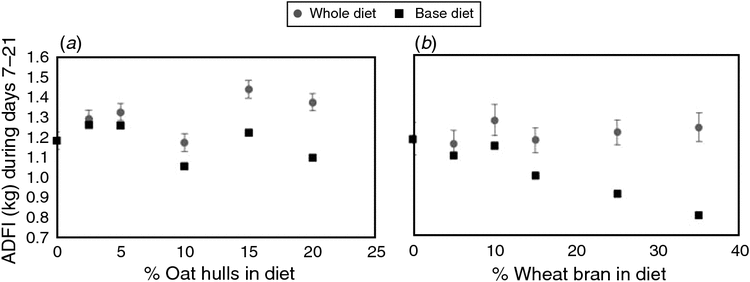Effects of different amounts of wheat bran and oat hulls in a starch-based diet on voluntary feed intake in grower pigs
V. Ratanpaul A , D. Zhang A B , B. A. Williams A , S. Diffey C , J. L. Black D and M. J. Gidley A EA ARC CoE in Plant Cell Walls, CNAFS, QAAFI, The University of Queensland, QLD 4072.
B School of Agriculture and Food Sciences, The University of Queensland, Gatton, QLD 4343.
C Apex Biometry, PO Box 690, South Fremantle, WA 6162.
D John L Black Consulting, PO Box 4021, Warrimoo, NSW 2774.
E Corresponding author. Email: m.gidley@uq.edu.au
Animal Production Science 57(12) 2436-2436 https://doi.org/10.1071/ANv57n12Ab025
Published: 20 November 2017
Feed intake in pigs fed ad libitum increases with decreasing feed energy density until a threshold is reached (Black et al. 2009). Indigestible fibre stimulates digesta passage rate and feed intake until the gut-capacity threshold is achieved. Undigested fibre in the distal ileum and colon stimulates the ‘intestinal brake’, which reduces digesta passage rate and feed intake (Black et al. 2009). The relative effects of passage rate increasing feed intake and the ‘intestinal brake’ reducing feed intake cannot be determined with conventional grain diets, as these contribute to both effects. The hypothesis tested in this experiment was that fibre source and level alters intake of a highly digestible starch-based diet diluted with various amounts of an indigestible fibre (oat hulls, OH) or a partially soluble fibre (wheat bran, WB).
The base diet contained maize starch (52.1%), fish meal (20%), dextrose (15%), soy protein (5%), Opticell lignocellulose (4%), amino acids, minerals and vitamins (2.4%) and sunflower oil (1.5%). Different amounts of OH (0, 2.5, 5, 10, 15 and 20%) or WB (0, 5, 10, 15, 25 and 35%) were added to the base diet and pelleted. A minimum of five pigs (male, Large White, initial bodyweight (BW) 19.7 ± 0.88kg (mean ± s.d.), 49 to 56 days old) were assigned, in a randomised block design, to each diet, which was fed ad libitum to pigs housed individually with free access to water over 21 days. Average daily feed intake (ADFI) was measured on dry matter basis at d 7, 14 and 21. Data were analysed using a linear mixed modelling approach, with initial BW as a covariate. Hydration capacity (HC; mL/g) was measured as the amount absorbed after soaking in excess water for 24 h and subsequent centrifugation. HC data were analysed by one-way ANOVA and Tukey test using ASReml, version 3 run on R platform (VSN International, Hemel Hempstead, UK). ADFI of OH diets tended to be higher (P = 0.053) than WB diets during 0 to 7, 7 to 21 and 0 to 21 days. ADFI of OH diets were over 4% higher (P = 0.021) than WB based diets for the 7 to 14 days period.
During 7 to 21 days (Fig. 1), basal diet intake increased ~7% as OH increased to 5%, but then decreased by ~8% with 20% OH. This suggested OH increased rate of passage and total intake, with intake maximised at 5% OH. Lower intake of the 10% OH diet could be due to higher HC (P < 0.001) compared to other OH diets (1.43 v. 1.23 to 1.31 mL/g), as this increases bulk and decreases intake (Kyriazakis and Emmans 1995). Feeding 10% WB reduced intake by ~4%. A steeper decline in intake to 30% below control for 35% WB diet was consistent with HC increasing from 1.30 (10% WB) to 1.63 mL/g (35% WB). Three factors may be interacting in WB diets: (1) initial increased rate of passage due to bulk; (2) reduced intake due to HC and bulk; (3) soluble fibre stimulating the intestinal brake. In conclusion, fibre source affects intake of basal diet.

|
References
Black JL, Williams BA, Gidley MJ (2009) In: ‘Voluntary feed intake in pigs’. (Eds D Torrallardona, E Roura) pp. 189–213. (Wageningen Academic Press: Wageningen)Kyriazakis I, Emmans G (1995) British Journal of Nutrition 73, 191–207.
| Crossref | GoogleScholarGoogle Scholar |
Supported by Pork CRC Limited Australia and the Australian Research Council Centre of Excellence in Plant Cell Walls (CE110001007).


